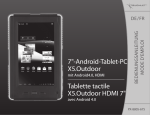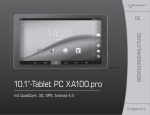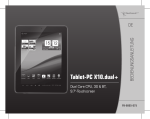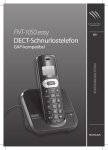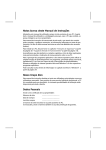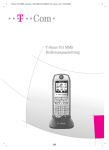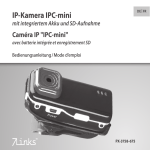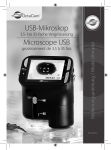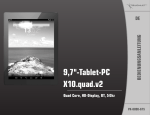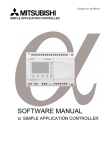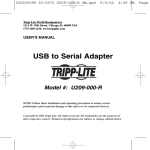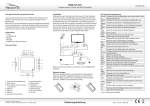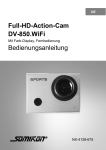Download ASS-17.quad - Billiger.de
Transcript
DEU ASS-17.quad 17"-All-in-One-PC mit 4-Kern-CPU & Android 4.0 PX-8811-675 - Bedienungsanleitung ASS-17.quad 17"-All-in-One-PC mit 4-Kern-CPU & Android 4.0 © 06/2013 - MK//ES//BR - GS Inhaltsverzeichnis Inhaltsverzeichnis DEU Ihr neuer 17" -All-in-One-PC.......................................................................... 6 Elektronische Version der Bedienungsanleitung herunterladen...................6 Lieferumfang.....................................................................................................................6 Produkteigenschaften....................................................................................................6 Wichtige Hinweise zu Beginn........................................................................ 7 Sicherheit............................................................................................................................7 Entsorgung von elektrischen und elektronischen Geräten.............................7 Hinweise zur Nutzung dieser Bedienungsanleitung..........................................8 Verwendete Symbole.....................................................................................................8 Verwendete Textmittel..................................................................................................8 Produktdetails................................................................................................. 9 Frontansicht........................................................................................................................9 Rückansicht.......................................................................................................................10 Inbetriebnahme............................................................................................ 11 Gerät ein- und ausschalten.........................................................................................11 Ruhezustand....................................................................................................................11 Kurzeinführung...............................................................................................................12 Startbildschirm................................................................................................................13 Benachrichtigungsleiste..............................................................................................14 Übersicht „Alle Apps“....................................................................................................16 Internetverbindung einrichten................................................................... 17 WLAN einrichten.............................................................................................................17 LAN einrichten.................................................................................................................17 Anhang........................................................................................................... 18 Technische Daten...........................................................................................................18 Konformitätserklärung.................................................................................................19 GNU GENERAL PUBLIC LICENSE............................................................................... 20 5 Ihr neuer 17" -All-in-One-PC DEU Ihr neuer 17" -All-in-One-PC Sehr geehrte Kundin, sehr geehrter Kunde, vielen Dank für den Kauf des 17"-All-in-One-PCs, eine geniale Kombination aus Desktop-PC und Android-Tablet. Surfen, Chatten, Multimedia – der PC läuft mit vielen Android-Apps. Mit dem leistungsstarken 4-Kern-Prozessor gehen selbst anspruchsvolle Aufgaben schnell und flüssig von der Hand. Bitte lesen Sie diese Bedienungsanleitung und befolgen Sie die darin aufgeführten Hinweise und Tipps, damit Sie Ihren neuen 17"-All-in-One-PC optimal nutzen können. Elektronische Version der Bedienungsanleitung herunterladen Dieses Dokument macht Sie mit der grundlegenden Bedienung des PCs vertraut. In der erweiterten Bedienungsanleitung finden Sie zahlreiche zusätzliche Informationen zum Umgang mit Android und dem Gerät. Öffnen Sie zum Herunterladen www.pearl.de und klicken Sie auf der linken Seite auf den Link Support (Handbücher, FAQ, Treiber & Co.). Geben Sie anschließend im Suchfeld die Artikelnummer PX-8811-675 ein. Zur Darstellung der erweiterten Anleitung benötigen Sie einen PDF-Reader, den Sie als Freeware im Internet finden. Den geläufigsten PDF-Reader Adobe Reader können Sie unter www.adobe.de zur kostenfreien Nutzung herunterladen. Lieferumfang • • • All-in-One-PC Netzteil Bedienungsanleitung Produkteigenschaften • • • • • • • 6 High-Definition-Auflösung: 1600 × 900 Pixel, 16:9 Format Freescale i.MX61 4-Kern-Prozessor Betriebssystem: Android 4.0 von Google 150 Mbit-WLAN IEEE 802.11 b/g/n 0,3 MP für Videotelefonie, X MP für Foto & Video 4 USB-Schnittstellen mit Host-Funktion Webcam, Lautsprecher Wichtige Hinweise zu Beginn Wichtige Hinweise zu Beginn DEU Sicherheit • • • • • • • • Diese Bedienungsanleitung dient dazu, Sie mit der Funktionsweise dieses Produktes vertraut zu machen. Bewahren Sie diese Anleitung daher stets gut auf, damit Sie jederzeit darauf zugreifen können. Ein Umbauen oder Verändern des Produktes beeinträchtigt die Produktsicherheit. Achtung Verletzungsgefahr! Öffnen Sie das Produkt niemals eigenmächtig. Führen Sie Reparaturen nie selbst aus! Behandeln Sie das Produkt sorgfältig. Es kann durch Stöße, Schläge oder Fall aus bereits geringer Höhe beschädigt werden. Halten Sie das Produkt fern von Feuchtigkeit und extremer Hitze. Tauchen Sie das Produkt niemals in Wasser oder andere Flüssigkeiten. Reinigen Sie das ausgeschaltete TFT-Display bei leichten, nicht fetthaltigen Verschmutzungen mit einem leicht angefeuchteten Mikrofasertuch. Gegebenenfalls können Sie das Mikrofasertuch mit einem reinen Glasreiniger befeuchten. Verwenden Sie keinen Allzweckreiniger. Sprühen Sie nie direkt auf das Display, sondern nur auf das Tuch. Technische Änderungen und Irrtümer vorbehalten! Entsorgung von elektrischen und elektronischen Geräten Ihr neues Produkt wurde mit größter Sorgfalt entwickelt und aus hochwertigen Komponenten gefertigt. Trotzdem muss das Produkt eines Tages entsorgt werden. Die durchgestrichene Mülltonne bedeutet, dass Ihr Produkt am Ende seiner Lebensdauer getrennt vom Hausmüll entsorgt werden muss. Bitte bringen Sie in Zukunft alle elektrischen oder elektronischen Geräte zu den eingerichteten kommunalen Sammelstellen in Ihrer Gemeinde. Diese nehmen Ihre Geräte entgegen und sorgen für eine ordnungsgemäße und umweltgerechte Verarbeitung. Dadurch verhindern Sie mögliche schädliche Auswirkungen auf Mensch und Umwelt, die sich durch unsachgemäße Handhabung von Produkten am Ende von deren Lebensdauer ergeben können. Genaue Informationen zur nächstgelegenen Sammelstelle erhalten Sie bei Ihrer Gemeinde. 7 Wichtige Hinweise zu Beginn DEU Hinweise zur Nutzung dieser Bedienungsanleitung Um diese Bedienungsanleitung möglichst effektiv nutzen zu können, finden Sie hier vorab einige Begriffe und Symbole erläutert, die Ihnen im Verlauf dieser Anleitung begegnen werden. Verwendete Symbole Dieses Symbol steht für mögliche Gefahren und wichtige Informationen im Umgang mit diesem Produkt. Es wird immer dann verwendet, wenn Sie eindringlich auf etwas hingewiesen werden sollen. Dieses Symbol steht für nützliche Hinweise und Informationen, die im Umgang mit dem Produkt helfen sollen Klippen zu umschiffen und Hürden zu nehmen. Verwendete Textmittel 8 GROSSBUCHSTABEN Großbuchstaben werden immer dann verwendet, wenn es gilt Tasten, Anschluss- oder andere Produkt-Beschriftungen kenntlich zu machen. Fettschrift Fettschrift wird immer dann eingesetzt, wenn Menüpunkte oder genau so bezeichnete Ausdrücke in der Software des Produktes verwendet werden. 1. 2. 3. Aufzählungen Aufzählungen Aufzählungen Aufzählungen werden immer dann verwendet, wenn Sie eine bestimmte Reihenfolge von Schritten befolgen oder die Merkmale des Produktes beziffert werden sollen. • • • Unterpunkte Unterpunkte Unterpunkte Unterpunkte werden immer dann verwendet, wenn mehrere Informationen aufgelistet werden. Sie dienen hauptsächlich zum besseren Kenntlichmachen der einzelnen Informationen. Produktdetails Produktdetails DEU Frontansicht Kameraobjektiv Diese Kamera (0,3 MP) kann beim Videochat oder der Videoaufnahme verwendet werden, um Sie aufzunehmen. Display TFT-Display, 1600 × 900 Pixel Ein/Aus-Taste Drücken Sie diese Taste lange, um den All-in-OnePC ein- bzw. auszuschalten. Drücken Sie sie kurz, um den PC in den Ruhezustand zu versetzen oder aus diesem zu erwecken. 9 Produktdetails DEU Rückansicht 10 USB-Anschluss Stecken Sie hier die Tastatur ein. USB-Anschluss Stecken Sie hier die Maus ein. 2 USB-Anschlüsse An diese USB-Anschlüsse können Sie weitere externe USB-Geräte anschließen (Festplatte, USB-Stick). WLAN-Empfänger Hierüber wird der PC per WLAN mit Ihrem Router verbunden. Kopfhöreranschluss Schließen Sie hier über ein 3,5mm-Klinkenkabel Lautsprecher oder Kopfhörer zur externen Audiowiedergabe an. LAN-Anschluss Stecken Sie hier das Netzwerkkabel zum Router ein. Netzteilbuchse Schließen Sie hier das mitgelieferte Netzteil an. Inbetriebnahme Inbetriebnahme DEU Packen Sie den PC vorsichtig aus und entfernen Sie die Schutzfolie vom Display. Stecken Sie die Maus und die Tastatur in die dafür vorgesehenen USB-Anschlüsse auf der Rückseite des Geräts, die entsprechend beschriftet sind. Verbinden Sie das Netzteil mit der Netzteilbuchse und einer gesicherten Steckdose. Gerät ein- und ausschalten Halten Sie die Ein/Aus-Taste einige Sekunden lang gedrückt, um das Gerät einzuschalten. Um das Gerät auszuschalten, halten Sie die Ein/Aus-Taste erneut einige Sekunden gedrückt und klicken Sie im sich öffnenden Dialog auf OK. Hinweis: Beim ersten Einschalten des PCs wird eine kurze Einführung gestartet. Ruhezustand Nach einigen Minuten der Nichtbenutzung schaltet sich der PC in den Ruhezustand. Sie können den Ruhezustand aufheben, indem Sie kurz die Ein/AusTaste drücken oder die Maus bewegen. Die Zeit, die bis zum Aktivieren des Ruhezustands vergeht, können Sie einstellen. Öffnen Sie hierzu die Übersicht „Alle Apps“ und klicken Sie auf Einstellungen und dann Display. Im rechten Fensterbereich können Sie unter Ruhezustand die gewünschte Zeit wählen. 11 Inbetriebnahme DEU Kurzeinführung Wenn Sie den PC das erste Mal einschalten, öffnet sich eine kurze Einführung für den Startbildschirm und die Übersicht „Alle Apps“ . Klicken Sie hier, um den ersten Einführungsbildschirm zu schließen. Klicken Sie hier, um die Übersicht „Alle Apps“ zu öffnen. Klicken Sie hier, um den zweiten Einführungsbildschirm zu schließen. 12 Inbetriebnahme Startbildschirm DEU Nach dem Einschalten des PCs öffnet sich der Startbildschirm. Hier können Sie Ihre favorisierten Apps ablegen. Indem Sie auf das Startbildschirm-Icon klicken, kehren Sie jederzeit zu diesem Bildschirm zurück. Klicken Sie auf diesen Eintrag, um den PC oder das Internet zu durchsuchen. Klicken Sie auf das Symbol der Sprachsteuerung, um verschiedene Funktionen per Spracheingabe aufzurufen. Klicken Sie auf das Übersicht-Symbol lierten Apps und Widgets aufzurufen. , um die Übersicht der instal- Dies ist der Hauptbildschirm. Hier können Sie Ihre favorisierten Apps ablegen. Ziehen Sie den Mauszeiger nach links oder rechts, um weitere Bereiche des Bildschirms anzuzeigen. Klicken Sie auf eine freie Stelle des Startbildschirms und halten Sie ihn gedrückt, um das Hintergrundbild zu ändern. Wählen Sie anschließend, ob das Hintergrundbild aus der Galerie, den gespeicherten Hintergrundbildern oder den Live-Hintergründen (interaktive, animierte Hintergrundbilder) stammen soll. Dies ist ein „Ordner“, eine Gruppierung mehrerer Apps. Halten Sie einfach eine App gedrückt und ziehen Sie sie auf eine andere, um die Anwendungen zu einer Gruppe zusammenzufassen. Klicken Sie auf den Ordner, um ihn zu öffnen. Klicken Sie auf den Namen des Ordners, um ihn umzubenennen. 13 Inbetriebnahme DEU Öffnen Sie häufig verwendete Apps, indem Sie sie anklicken. Eine App legen Sie auf dem Startbildschirm ab, indem Sie in der Übersicht „Alle Apps“ die gewünschte App anklicken und die Maustaste gedrückt halten. Nach einem Moment wechselt die Übersichtsansicht zum Startbildschirm. Lassen Sie an der gewünschten Stelle die Maustaste los. Wenn Sie eine App vom Startbildschirm entfernen möchten, klicken Sie darauf und halten Sie den Mauszeiger gedrückt, bis am oberen Bildschirmrand ein X erscheint. Ziehen Sie sie anschließend auf das X und lassen Sie sie dort los. Die App wird hierbei nicht deinstalliert. Dies ist die Benachrichtigungsleiste. Details finden Sie im nächsten Abschnitt. Benachrichtigungsleiste Die Benachrichtigungsleiste bietet Ihnen einige Steuerelemente, die immer angezeigt werden, sowie einige grundlegenden Benachrichtigungen über die aktuelle Zeit, eventuelle Verbindungen (WLAN, USB) etc. Zurück Startbildschirm Kürzlich verwendete Apps Lautstärke verringern Lautstärke erhöhen 14 Klicken Sie auf dieses Symbol, um zum vorherigen Bildschirm / zur vorherigen Seite zurückzukehren und um Anwendungen / Menüs zu schließen. Klicken Sie auf dieses Symbol, um jederzeit zum Startbildschirm zurückzukehren. Öffnet eine Liste mit Miniaturansichten der zuletzt verwendeten Apps. Klicken Sie auf eine App, wenn Sie diese öffnen möchten. Um eine App aus der Liste zu entfernen, schieben Sie die Miniaturansicht nach links oder rechts. Klicken Sie auf dieses Symbol, um die Lautstärke der Audio-Wiedergabe zu verringern. Klicken Sie auf dieses Symbol, um die Lautstärke der Audio-Wiedergabe zu erhöhen. Inbetriebnahme Auszoomen Einzoomen Menü Benachrichtigungen Klicken Sie auf dieses Symbol, um etwas zu verkleinern (auszoomen). Fotos und Webseiten können Sie auch durch einen Doppelklick auszoomen. DEU Klicken Sie auf dieses Symbol, um etwas zu vergrößern (einzoomen). Fotos und Webseiten können Sie auch durch einen Doppelklick einzoomen. Klicken Sie auf dieses Symbol, um ein Kontextmenü für den aktuellen Bildschirm aufzurufen. Kontextmenüs sind nicht immer verfügbar. Hier finden Sie aktuelle Benachrichtigungen. Klicken Sie auf diesen Bereich, um eine erweiterte Anzeige der Benachrichtigungsleiste zu öffnen. Hinweis: Wenn Sie mit der rechten Maustaste klicken, wird ebenfalls die Aktion Zurück ausgeführt wie oben beschrieben. 15 Inbetriebnahme DEU Übersicht „Alle Apps“ auf dem Startbildschirm gelangen Sie in die Über das Übersicht-Symbol Übersicht „Alle Apps“. Hier finden Sie eine Liste aller installierter Apps und Widgets. Hier können Sie die Ansicht zwischen „Apps“ und „Widgets“ umschalten. „Widgets“ sind kleine Zusatzprogramme, die Sie auf dem Startbildschirm ablegen können. Klicken Sie auf dieses Symbol, um den Google-Shop „Google Play“ zu öffnen. Dies sind die installierten Apps. Klicken Sie auf eine App, um sie zu öffnen. Ziehen Sie den Bildschirm mit gedrücktem Mauszeiger nach links oder nach rechts, um weitere Apps und Widgets anzuzeigen. Hinweis: Eine App legen Sie auf dem Startbildschirm ab, indem Sie in der Übersicht „Alle Apps“ die gewünschte App anklicken und die Maustaste gedrückt halten. Nach einem Moment wechselt die Übersichtsansicht zum Startbildschirm. Lassen Sie an der gewünschten Stelle die Maustaste los. Einen App-Ordner legen Sie an, indem Sie mehrere Apps aufeinander ziehen. 16 Internetverbindung einrichten Internetverbindung einrichten DEU Öffnen Sie die App Einstellungen. Gleich oben in den Einstellungen finden Sie den Menüpunkt DRAHTLOS & NETZWERKE. WLAN einrichten Klicken Sie auf den Eintrag WLAN, werden rechts die verfügbaren WLANs angezeigt. Wenn die verfügbaren WLANs nicht angezeigt werden, klicken Sie auf den Eintrag AUS und der Eintrag ändert sich auf AN. Verfügbare WLAN-Netze werden gesucht und angezeigt. Wählen Sie das gewünschte WLAN aus und geben Sie im neu geöffneten Fenster das Passwort für das WLAN ein (falls erforderlich) und wählen Sie Verbinden. HINWEIS: Die Standardeinstellung verwendet DHCP. Wenn Sie Ihr WLAN anders konfiguriert haben, aktivieren Sie die Checkbox Erweiterte Optionen einblenden und geben Sie Ihre Einstellungen ein. LAN einrichten Verbinden Sie den PC mithilfe eines LAN-Kabels mit einem Router oder Modem. Wählen Sie den Menüpunkt Ethernet und klicken Sie gegebenenfalls auf AUS. Der Eintrag ändert sich auf AN. Wählen Sie Ethernet-Konfiguration und geben Sie Ihre Verbindungsdaten ein. Aktivieren Sie die Schaltfläche Speichern. 17 Anhang DEU Anhang Technische Daten 18 Prozessor ARM Cortex A9 1,2 GHZ TFT-Display 17,3” (43,9 cm) Auflösung 1600 x 900 Pixel Kamera 0,3 MP Betriebssystem Google Android 4.0.4 Arbeitsspeicher 1 GB, DDR3 WLAN IEEE 802.11 b/g/n bis 150 MBit/Sekunde Ethernet-Zugang 10/100/1000 MBit, Buchse RJ-45 USB-Anschlüsse 4 USB-Ports 2.0 Unterstützte Formate JPG, PNG, BMP, GIF Audiocodecs MP3, WMA, FLAC, AAC, AC3, OGG, WAV Videocodecs H.263, H.264, MPEG 1/2/4, DIVX, WMV, MKV, AVI, OGG, FLV: 1080 Pixel @ 30fps, RM, RMVB: 720P @ 30fps E-Book-Formate EPUB, PDF, TXT, HTML Netzteil 220-240 V Stromanschluss 12 Volt / 2,5 A Maße 420 x 335 x 135 mm Gewicht 1340 g Anhang DEU Konformitätserklärung Hiermit erklärt PEARL.GmbH, dass sich das Produkt PX-8811 in Übereinstimmung mit der Niederspannungsrichtlinie 2006/95/EG, der R&TTE-Richtlinie 99/5/EG und der RoHS-Richtlinie 2011/65/EU befindet. PEARL.GmbH, PEARL-Str. 1-3, 79426 Buggingen, Deutschland Leiter Qualitätswesen Dipl. Ing. (FH) Andreas Kurtasz 17.06.2013 Die ausführliche Konformitätserklärung finden Sie unter www.pearl.de. Klicken Sie auf der linken Seite auf den Link Support (Handbücher, FAQs, Treiber & Co.). Geben Sie anschließend im Suchfeld die Artikelnummer PX-8811 ein. 19 GNU GENERAL PUBLIC LICENSE DEU Dieses Produkt enthält Software, welche ganz oder teilweise als freie Software den Lizenzbedingungen der GNU General Public License, Version 2 (GPL) unterliegt. Den Quellcode der Software erhalten Sie unter http://www.pearl.de/support/ unter dortiger Eingabe der Artikelnummer; wir senden Ihnen auf Anforderung (gerne unter unter [email protected]) den SourceCode auch auf einem handelsüblichen Datenträger, dessen Herstellungskosten wir im Gegenzug geltend machen; den vollständigen Lizenztext ersehen Sie nachfolgend. Näheres, insbesondere auch dazu, warum es keine offizielle deutsche Übersetzung der Lizenzbedingungen gibt, erfahren Sie unter http://www.gnu.org/licenses/gpl‐2.0.html. Da es sich um freie Software handelt, schließen die Entwickler dieser Software die Haftung, soweit gesetzlich zulässig, aus. Bitte beachten Sie, dass die Gewährleistung für die Hardware davon natürlich nicht betroffen ist und in vollem Umfang besteht. Weitere Fragen beantworten wir Ihnen gerne unter [email protected]. GNU GENERAL PUBLIC LICENSE Version 2, June 1991 Copyright (C) 1989, 1991 Free Software Foundation, Inc. 51 Franklin Street, Fifth Floor, Boston, MA 02110-1301, USA Everyone is permitted to copy and distribute verbatim copies of this license document, but changing it is not allowed. Preamble The licenses for most software are designed to take away your freedom to share and change it. By contrast, the GNU General Public License is intended to guarantee your freedom to share and change free software--to make sure the software is free for all its users. This General Public License applies to most of the Free Software Foundation‘s software and to any other program whose authors commit to using it. (Some other Free Software Foundation software is covered by the GNU Lesser General Public License instead.) You can apply it to your programs, too. When we speak of free software, we are referring to freedom, not price. Our General Public Licenses are designed to make sure that you have the freedom to distribute copies of free software (and charge for this service if you wish), that you receive source code or can get it if you want it, that you can change the software or use pieces of it in new free programs; and that you know you can do these things. 20 GNU GENERAL PUBLIC LICENSE To protect your rights, we need to make restrictions that forbid anyone to deny you these rights or to ask you to surrender the rights. These restrictions translate to certain responsibilities for you if you distribute copies of the software, or if you modify it. For example, if you distribute copies of such a program, whether gratis or for a fee, you must give the recipients all the rights that you have. You must make sure that they, too, receive or can get the source code. And you must show them these terms so they know their rights. We protect your rights with two steps: (1) copyright the software, and (2) offer you this license which gives you legal permission to copy, distribute and/or modify the software. DEU Also, for each author‘s protection and ours, we want to make certain that everyone understands that there is no warranty for this free software. If the software is modified by someone else and passed on, we want its recipients to know that what they have is not the original, so that any problems introduced by others will not reflect on the original authors‘ reputations. Finally, any free program is threatened constantly by software patents. We wish to avoid the danger that redistributors of a free program will individually obtain patent licenses, in effect making the program proprietary. To prevent this, we have made it clear that any patent must be licensed for everyone‘s free use or not licensed at all. The precise terms and conditions for copying, distribution and modification follow. TERMS AND CONDITIONS FOR COPYING, DISTRIBUTION AND MODIFICATION 4. This License applies to any program or other work which contains a notice placed by the copyright holder saying it may be distributed under the terms of this General Public License. The „Program“, below, refers to any such program or work, and a „work based on the Program“ means either the Program or any derivative work under copyright law: that is to say, a work containing the Program or a portion of it, either verbatim or with modifications and/or translated into another language. (Hereinafter, translation is included without limitation in the term „modification“.) Each licensee is addressed as „you“. Activities other than copying, distribution and modification are not covered by this License; they are outside its scope. The act of running the Program is not restricted, and the output from the Program is covered only if its contents constitute a work based on the Program (independent of having been made by running the Program). Whether that is true depends on what the Program does. 21 GNU GENERAL PUBLIC LICENSE 5. DEU You may copy and distribute verbatim copies of the Program‘s source code as you receive it, in any medium, provided that you conspicuously and appropriately publish on each copy an appropriate copyright notice and disclaimer of warranty; keep intact all the notices that refer to this License and to the absence of any warranty; and give any other recipients of the Program a copy of this License along with the Program. You may charge a fee for the physical act of transferring a copy, and you may at your option offer warranty protection in exchange for a fee. 6. You may modify your copy or copies of the Program or any portion of it, thus forming a work based on the Program, and copy and distribute such modifications or work under the terms of Section 1 above, provided that you also meet all of these conditions: a) You must cause the modified files to carry prominent notices stating that you changed the files and the date of any change. b) You must cause any work that you distribute or publish, that in whole or in part contains or is derived from the Program or any part thereof, to be licensed as a whole at no charge to all third parties under the terms of this License. c) If the modified program normally reads commands interactively when run, you must cause it, when started running for such interactive use in the most ordinary way, to print or display an announcement including an appropriate copyright notice and a notice that there is no warranty (or else, saying that you provide a warranty) and that users may redistribute the program under these conditions, and telling the user how to view a copy of this License. (Exception: if the Program itself is interactive but does not normally print such an announcement, your work based on the Program is not required to print an announcement.) These requirements apply to the modified work as a whole. If identifiable sections of that work are not derived from the Program, and can be reasonably considered independent and separate works in themselves, then this License, and its terms, do not apply to those sections when you distribute them as separate works. But when you distribute the same sections as part of a whole which is a work based on the Program, the distribution of the whole must be on the terms of this License, whose permissions for other licensees extend to the entire whole, and thus to each and every part regardless of who wrote it. Thus, it is not the intent of this section to claim rights or contest your rights to work written entirely by you; rather, the intent is to exercise the right to control the distribution of derivative or collective works based on the Program. 22 GNU GENERAL PUBLIC LICENSE In addition, mere aggregation of another work not based on the Program with the Program (or with a work based on the Program) on a volume of a storage or distribution medium does not bring the other work under the scope of this License. 7. DEU You may copy and distribute the Program (or a work based on it, under Section 2) in object code or executable form under the terms of Sections 1 and 2 above provided that you also do one of the following: a) Accompany it with the complete corresponding machine-readable source code, which must be distributed under the terms of Sections 1 and 2 above on a medium customarily used for software interchange; or, b) Accompany it with a written offer, valid for at least three years, to give any third party, for a charge no more than your cost of physically performing source distribution, a complete machine-readable copy of the corresponding source code, to be distributed under the terms of Sections 1 and 2 above on a medium customarily used for software interchange; or, c) Accompany it with the information you received as to the offer to distribute corresponding source code. (This alternative is allowed only for noncommercial distribution and only if you received the program in object code or executable form with such an offer, in accord with Subsection b above.) The source code for a work means the preferred form of the work for making modifications to it. For an executable work, complete source code means all the source code for all modules it contains, plus any associated interface definition files, plus the scripts used to control compilation and installation of the executable. However, as a special exception, the source code distributed need not include anything that is normally distributed (in either source or binary form) with the major components (compiler, kernel, and so on) of the operating system on which the executable runs, unless that component itself accompanies the executable. If distribution of executable or object code is made by offering access to copy from a designated place, then offering equivalent access to copy the source code from the same place counts as distribution of the source code, even though third parties are not compelled to copy the source along with the object code. 8. You may not copy, modify, sublicense, or distribute the Program except as expressly provided under this License. Any attempt otherwise to copy, modify, sublicense or distribute the Program is void, and will automatically terminate your rights under this License. However, parties who have received copies, or rights, from you under this License will not have their licenses terminated so long as such parties remain in full compliance. 23 GNU GENERAL PUBLIC LICENSE 9. DEU You are not required to accept this License, since you have not signed it. However, nothing else grants you permission to modify or distribute the Program or its derivative works. These actions are prohibited by law if you do not accept this License. Therefore, by modifying or distributing the Program (or any work based on the Program), you indicate your acceptance of this License to do so, and all its terms and conditions for copying, distributing or modifying the Program or works based on it. 10. Each time you redistribute the Program (or any work based on the Program), the recipient automatically receives a license from the original licensor to copy, distribute or modify the Program subject to these terms and conditions. You may not impose any further restrictions on the recipients‘ exercise of the rights granted herein. You are not responsible for enforcing compliance by third parties to this License. 11. If, as a consequence of a court judgment or allegation of patent infringement or for any other reason (not limited to patent issues), conditions are imposed on you (whether by court order, agreement or otherwise) that contradict the conditions of this License, they do not excuse you from the conditions of this License. If you cannot distribute so as to satisfy simultaneously your obligations under this License and any other pertinent obligations, then as a consequence you may not distribute the Program at all. For example, if a patent license would not permit royaltyfree redistribution of the Program by all those who receive copies directly or indirectly through you, then the only way you could satisfy both it and this License would be to refrain entirely from distribution of the Program. If any portion of this section is held invalid or unenforceable under any particular circumstance, the balance of the section is intended to apply and the section as a whole is intended to apply in other circumstances. It is not the purpose of this section to induce you to infringe any patents or other property right claims or to contest validity of any such claims; this section has the sole purpose of protecting the integrity of the free software distribution system, which is implemented by public license practices. Many people have made generous contributions to the wide range of software distributed through that system in reliance on consistent application of that system; it is up to the author/donor to decide if he or she is willing to distribute software through any other system and a licensee cannot impose that choice. This section is intended to make thoroughly clear what is believed to be a consequence of the rest of this License. 24 GNU GENERAL PUBLIC LICENSE 12. If the distribution and/or use of the Program is restricted in certain countries either by patents or by copyrighted interfaces, the original copyright holder who places the Program under this License may add an explicit geographical distribution limitation excluding those countries, so that distribution is permitted only in or among countries not thus excluded. In such case, this License incorporates the limitation as if written in the body of this License. DEU 13. The Free Software Foundation may publish revised and/or new versions of the General Public License from time to time. Such new versions will be similar in spirit to the present version, but may differ in detail to address new problems or concerns. Each version is given a distinguishing version number. If the Program specifies a version number of this License which applies to it and „any later version“, you have the option of following the terms and conditions either of that version or of any later version published by the Free Software Foundation. If the Program does not specify a version number of this License, you may choose any version ever published by the Free Software Foundation. 14. If you wish to incorporate parts of the Program into other free programs whose distribution conditions are different, write to the author to ask for permission. For software which is copyrighted by the Free Software Foundation, write to the Free Software Foundation; we sometimes make exceptions for this. Our decision will be guided by the two goals of preserving the free status of all derivatives of our free software and of promoting the sharing and reuse of software generally. NO WARRANTY 15. BECAUSE THE PROGRAM IS LICENSED FREE OF CHARGE, THERE IS NO WARRANTY FOR THE PROGRAM, TO THE EXTENT PERMITTED BY APPLICABLE LAW. EXCEPT WHEN OTHERWISE STATED IN WRITING THE COPYRIGHT HOLDERS AND/OR OTHER PARTIES PROVIDE THE PROGRAM „AS IS“ WITHOUT WARRANTY OF ANY KIND, EITHER EXPRESSED OR IMPLIED, INCLUDING, BUT NOT LIMITED TO, THE IMPLIED WARRANTIES OF MERCHANTABILITY AND FITNESS FOR A PARTICULAR PURPOSE. THE ENTIRE RISK AS TO THE QUALITY AND PERFORMANCE OF THE PROGRAM IS WITH YOU. SHOULD THE PROGRAM PROVE DEFECTIVE, YOU ASSUME THE COST OF ALL NECESSARY SERVICING, REPAIR OR CORRECTION. 25 GNU GENERAL PUBLIC LICENSE DEU 16. IN NO EVENT UNLESS REQUIRED BY APPLICABLE LAW OR AGREED TO IN WRITING WILL ANY COPYRIGHT HOLDER, OR ANY OTHER PARTY WHO MAY MODIFY AND/OR REDISTRIBUTE THE PROGRAM AS PERMITTED ABOVE, BE LIABLE TO YOU FOR DAMAGES, INCLUDING ANY GENERAL, SPECIAL, INCIDENTAL OR CONSEQUENTIAL DAMAGES ARISING OUT OF THE USE OR INABILITY TO USE THE PROGRAM (INCLUDING BUT NOT LIMITED TO LOSS OF DATA OR DATA BEING RENDERED INACCURATE OR LOSSES SUSTAINED BY YOU OR THIRD PARTIES OR A FAILURE OF THE PROGRAM TO OPERATE WITH ANY OTHER PROGRAMS), EVEN IF SUCH HOLDER OR OTHER PARTY HAS BEEN ADVISED OF THE POSSIBILITY OF SUCH DAMAGES. END OF TERMS AND CONDITIONS How to Apply These Terms to Your New Programs If you develop a new program, and you want it to be of the greatest possible use to the public, the best way to achieve this is to make it free software which everyone can redistribute and change under these terms. To do so, attach the following notices to the program. It is safest to attach them to the start of each source file to most effectively convey the exclusion of warranty; and each file should have at least the „copyright“ line and a pointer to where the full notice is found. one line to give the program‘s name and an idea of what it does. Copyright (C) yyyy name of author This program is free software; you can redistribute it and/or modify it under the terms of the GNU General Public License as published by the Free Software Foundation; either version 2 of the License, or (at your option) any later version. This program is distributed in the hope that it will be useful, but WITHOUT ANY WARRANTY; without even the implied warranty of MERCHANTABILITY or FITNESS FOR A PARTICULAR PURPOSE. See the GNU General Public License for more details. You should have received a copy of the GNU General Public License along with this program; if not, write to the Free Software Foundation, Inc., 51 Franklin Street, Fifth Floor, Boston, MA 02110-1301, USA. Also add information on how to contact you by electronic and paper mail. If the program is interactive, make it output a short notice like this when it starts in an interactive mode: 26 GNU GENERAL PUBLIC LICENSE Gnomovision version 69, Copyright (C) year name of author Gnomovision comes with ABSOLUTELY NO WARRANTY; for details type `show w‘. This is free software, and you are welcome to redistribute it under certain conditions; type `show c‘ for details. DEU The hypothetical commands `show w‘ and `show c‘ should show the appropriate parts of the General Public License. Of course, the commands you use may be called something other than `show w‘ and `show c‘; they could even be mouse-clicks or menu items - whatever suits your program. You should also get your employer (if you work as a programmer) or your school, if any, to sign a „copyright disclaimer“ for the program, if necessary. Here is a sample; alter the names: Yoyodyne, Inc., hereby disclaims all copyright interest in the program `Gnomovision‘ (which makes passes at compilers) written by James Hacker. signature of Ty Coon, 1 April 1989 Ty Coon, President of Vice This General Public License does not permit incorporating your program into proprietary programs. If your program is a subroutine library, you may consider it more useful to permit linking proprietary applications with the library. If this is what you want to do, use the GNU Lesser General Public License instead of this License. 27




























